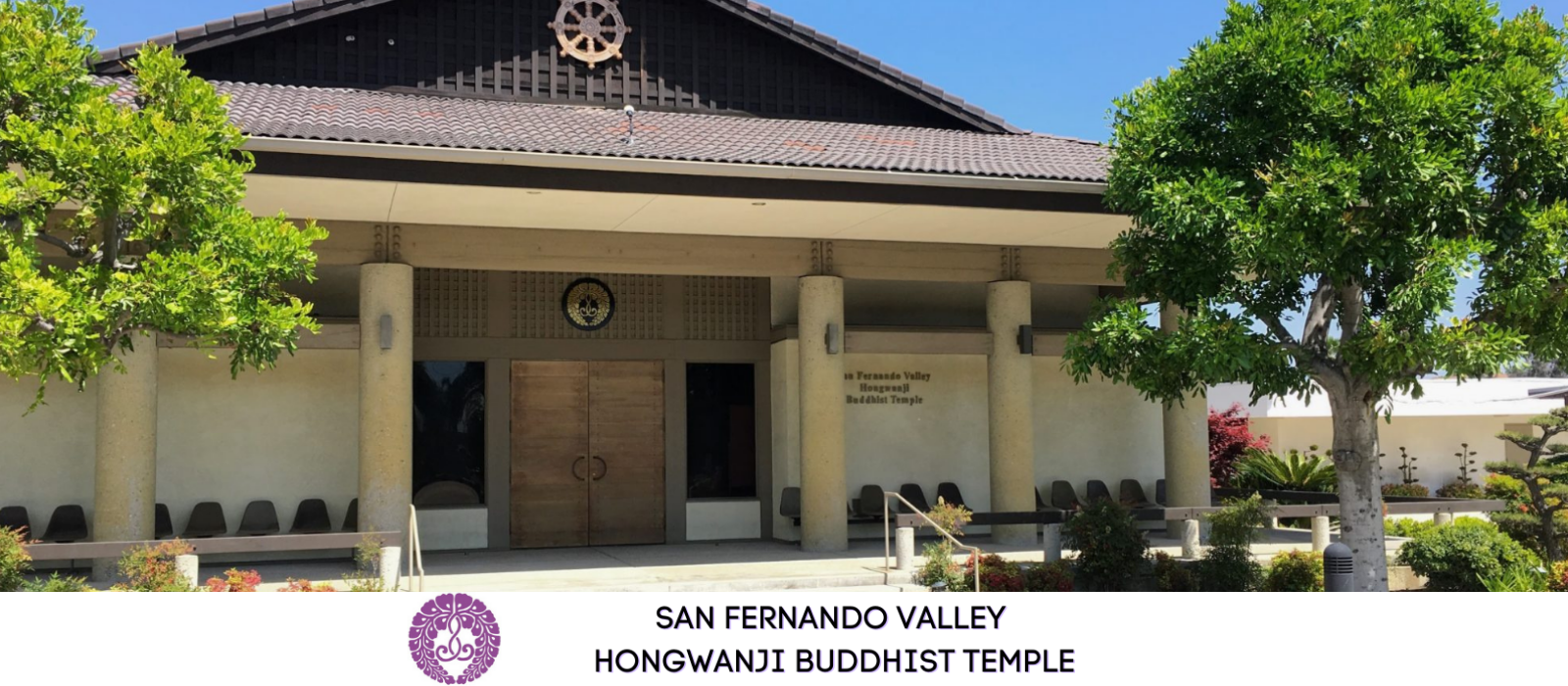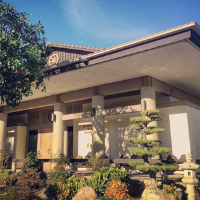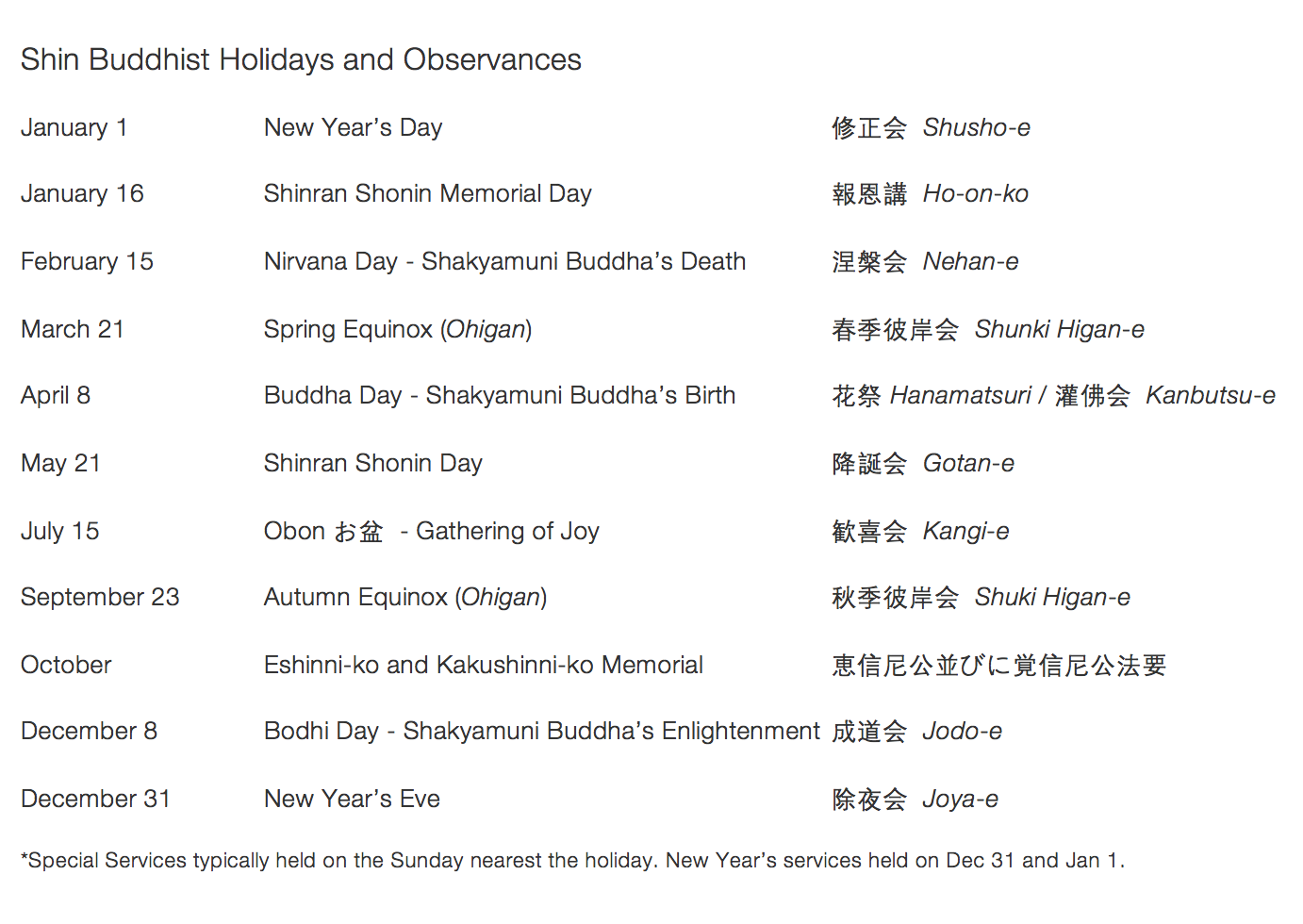Services and Observances
A service is a time when sangha members and friends gather to listen to the dharma (Buddhist teachings).
All services at SFVHBT feature a dharma talk by the minister. There are also rituals to prepare us to listen to and receive the dharma. Many of the rituals are performed together by the minister and sangha, typically guided by the minister. Those who attend are welcome to offer incense, recite the nembutsu (Namo Amida Butsu), chant, read, and sing with our sangha.
Everyone is welcome to attend temple services (excluding private family memorial observances). Visitors may participate in the service, or simply listen and observe. For dates and times of services, please check our Calendar.
TEMPLE ETIQUETTE
The word “etiquette” doesn’t really cover the feeling behind customary actions in the temple building. These actions are based on the reverence and respect we should feel about the Buddha, Dharma, and Sangha. All of these exist to guide us toward a life of inner peace and harmony.
If we listen to the dharma and apply it to our everyday lives, we will realize some important truths. One is that we are forever caught in a cycle of duhkha (struggle, suffering, stress, dissatisfaction, feeling out of kilter) brought on by our greed, aversion, and delusion. Once we become aware that it is impossible for us to be perfect and pure, we begin to see ourselves as we really are. When we learn about interdependence, we become aware that nothing we are, nothing we have, and nothing we do exists without the existence of countless others. Everything is thanks to others—it’s a humbling experience, and there’s so much to be grateful for.
When we enter the hondo (temple), we are entering the realm of Amida Buddha, the representation of Ultimate Wisdom (the insight into interdependence/Oneness) and Compassion (the unconditional commitment to liberate all beings from the cycle of struggle). A buddha is one who has awakened to Truth. We all have the potential to become buddhas, but we’re not there yet. We come to the temple to hear the dharma teachings so we can apply them in our daily lives and attain a sense of well-being that will allow us to live each moment to the fullest. When we think of how the dharma can shape the quality of our lives, we really do need to be reverent and respectful. It is in this spirit that we engage in the following customs:
Onenju: Please come to service with your onenju. If you forget it, you can borrow one from the basket at the lobby entrance. Hold your onenju in your left hand throughout the service. When you gassho, the onenju should encircle both hands (ask about the symbolism!). Treat your onenju with respect at all times and keep it in a safe place. It is also a good practice to wear your okesa, which shows that you are ready to hear the dharma. If you are a member and do not have one, please see the minister.
“Namo Amida Butsu”: It is never wrong to say the nembutsu. It is a spontaneous expression of gratitude, as well as having other personal meanings. It is said before and after chanting, and after meditations, gathas and dharma talks. The minister usually leads in saying it because people do not observe the habit of saying it spontaneously. There is no predetermined number of times to repeat it on your own.
Entering and Exiting the Hondo (at all doors): Face the altar area (onaijin) and make a slight bow. Please do not bring food or beverages of any kind into the hondo.
Before Service Begins: When you sit down, it is customary to put your hands together in gassho, say a quiet nembutsu (“Namo Amida Butsu”), and bow slightly. Sit in quiet reflection. This may be one of the few opportunities you have all week to do so, and it is important for your spiritual well-being. If you need to talk with someone, please go to the lobby or outside—others will appreciate it.
Offering Incense (Oshoko): If there is time before the kansho bell is rung, you may offer incense at one of the three burners. Stop about two paces away from the incense table. Bow slightly, approach the burner left foot first, take one small pinch of granular incense with your right hand, and drop it into the burner. Put your hands together in gassho, say nembutsu, step back with your right foot, bow slightly again, and return to your seat. If you do not have time at the beginning of the service, you may offer incense at the end.
Kansho: This is the “calling bell” that is struck at the beginning of the service. We can think of it as Amida Buddha calling us to come and hear the dharma. If you listen to each sound as it disappears, it will help you to become more reflective and ready for the service.
Onaijin: The altar area represents the Pure Land of Amida Buddha, or nirvana. Everything in it is symbolic. Only ordained ministers may enter this area, though they may give permission to others to enter for special reasons.
If you walk across the front of the Onaijin, it is customary to give a slight bow as you pass in front of the main and side altars. Again, this is out of respect for Amida Buddha (representing Infinite Wisdom and Compassion), as well as for Shinran Shonin and Rennyo Shonin. In some temples, there are two additional side altars. To learn more, see Buddhist Altar (Naijin Shrine).
Books: Whenever we use a book for chanting, recitation, or singing gathas, we remember that it contains sacred words of wisdom. Therefore, before and after using a book, we show our reverence by raising the closed book toward our forehead. Out of respect, never lay a book directly on the seat or on the floor.
Conclusion: Please leave quickly and quietly, as there may be an activity immediately following service. If the minister is standing outside the door, please be sure to greet him or her and introduce yourself!
There’s no such thing as bachi (retribution) if you forget to do something. The main point is that the hondo is a place of reverence and respect. By maintaining this atmosphere, you will be able to carry it with you in your heart wherever you go. Whenever you turn to the Buddha and Dharma for comfort and guidance, you will always have the good feeling that the SFVHBT Sangha creates together in our beautiful temple.
See Buddhist Etiquette for more information, and don’t hesitate to ask if you have questions!
REGULAR SERVICE
Regular service is held on most Sunday mornings at 10am. SFVHBT welcomes a mix of all ages at services, and children and parents are encouraged to attend as a family. Guests or visitors are always welcome.
The service is conducted in English, with certain readings and songs in Japanese. At some services, the minister gives one talk in English and another in Japanese (English-only attendees are given time to leave).
Activities and meetings are often held following regular service.
SPECIAL SERVICES
Certain days are set aside to commemorate people or events of particular importance to Buddhists. Some are observed by most or all Buddhists, such as the birth of Shakyamuni Buddha; others are commemorated by Jodo Shinshu followers only, such as those pertaining to Shinran Shonin.
The special service format is nearly the same as for regular service, with the addition of a special pronouncement (hyobyakumon) declaring the purpose of the gathering and incense offering by temple organization representatives. Some holidays are marked by a ritual specific to that day, such as “bathing the baby Buddha” for Buddha Day (Hanamatsuri). A guest speaker may be invited to give the dharma talk. Otoki (shared meal) follows most special services, so sangha members can welcome the guest speaker and spend time with fellow members and visitors.
January 1: New Year’s Day – Shusho-e
Jodo Shinshu views New Year’s Day as a time to reflect and, with renewed dedication, to endeavor to live a life of gratitude and joy.
New Year’s Day service originated in Japan during the Nara period (710-794 CE). In BCA temples, a service is held during the morning of New Year’s Day. In Japan, some temples have a traditional seven-day observance. The original purpose of this service was to wish for world peace and to extend a blessing to the Emperor. For Jodo Shinshu followers, it is a time for self-reflection and for expressing gratitude.
January 16: Shinran Shonin Memorial Day – Ho-on-ko
The most important Jodo Shinshu observance is Shinran Shonin Memorial Day, which marks the death of Shinran, the father of Jodo Shinshu. It is one of two occasions commemorating Shinran, the other being his birthday in May (Shinran Shonin Day). Nishi Hongwanji observes the date of death on January 16, culminating seven days of services and dharma talks.
Kakunyo Shonin, great grandson of Shinran and the third Gomonshu, initiated Shinran Shonin Memorial Day services. Memorial services are opportunities to listen to the dharma and to contemplate, with gratitude, the causes and conditions that enable us to listen to the dharma. On this particular occasion, we reflect upon Shinran and his tireless efforts to make a life of gratitude accessible to everyone.
February 15: Nirvana Day – Nehan-e
Nirvana Day marks the day Shakyamuni Buddha died and entered parinirvana (complete, perfect nirvana). Although he had awakened to Truth, having realized enlightenment, or reached nirvana, at thirty-five, he did not enter parinirvana until his death at eighty. Nirvana Day is one of three observances commemorating Shakyamuni Buddha, along with his birthday (Buddha Day, April) and his enlightenment (Bodhi Day, December).
The death of Shakyamuni Buddha underscores the teaching of impermanence, the idea that we, and all beings and things in this world we live in, are subject to constant change. It was Shakyamuni Buddha’s intent, through his teachings, that we understand the transitory nature of our existence, the cause of our suffering, and to experience Truth.
March 21: Spring Equinox – Shunki Higan-e
Higan literally means “other shore”; it refers to nirvana or enlightenment or Pure Land. By contrast, shigan means “this shore” of samsara, the everyday world in which we live. The focus of Ohigan is practicing the Six Paramitas (giving, discipline, patience, endeavor, meditation, wisdom) as a means to reach the “other shore.” In Jodo Shinshu, the emphasis is on expressing gratitude for the working of the Primal Vow, which Bodhisattva Dharmakara fulfilled through his practice of the Six Paramitas and other rigorous spiritual endeavors.
Ohigan is observed twice a year, during spring equinox and fall equinox. Having originated in Japan in the early Heian period, it has no direct connection to Shakyamuni Buddha nor any other teacher.
April 8: Buddha Day – Hanamatsuri – Birth of Shakyamuni Buddha
Buddha Day celebrates the birth of the historical Buddha, Shakyamuni Buddha. Although it is called Hanamatsuri (flower festival) in Japanese, the more proper name is Kanbutsu-e (bathe-Buddha-gathering), in reference to the ritual of pouring sweet tea over a statue of the baby Buddha. The pouring of tea represents the gentle rain, perfumed by flower petals, that are said to have fallen in Lumbini Garden when the Buddha was born. Buddha Day is a visually memorable occasion because of the beautifully decorated flower-pavilion (hanamido) used to shelter the baby Buddha statue.
May 21: Shinran Shonin Day – Gotan-e
Shinran Shonin Day celebrates the birth of the father of Jodo Shinshu. It is one of two observances commemorating Shinran, the other being Shinran Shonin Memorial Day in January. Gotan-e means “coming down-birthday-gathering.” Another name for this occasion is Fujimatsuri (wisteria festival). The double-wisteria crest is the temple crest of Nishi Hongwanji. The pendant wisteria blossoms suggest humility and sincere reverence to Amida.
July 15 – August 15: Obon
Obon is a Buddhist Memorial Day during which we remember all deceased with gratitude for enabling us to exist and to encounter the dharma. As Shinran observed, “all sentient beings, without exception, have been our parents and brothers and sisters in the course of countless lives in the many states of existence” (Yuien, Tannisho, Chapter 5).
Obon is so-called because of the mythological Ullambana Sutra (Jpn. Urabon) story describing how Mokuren (Mogallana, Maudgalyayana) danced with joy upon the release of his mother from the hell-realm of Hungry Ghosts. For Jodo Shin Buddhists, it is important to note that the outdoor folk dancing is done in memory of the deceased, and not to generate merit for them nor to welcome the spirits of the departed. Thus, it is also called Gathering of Joy (Kangi-e) in grateful remembrance of all those who have influenced our lives.
September 23: Fall Equinox – Shuki Higan-e
See “March 21: Spring Equinox.”
October: Eshinni-ko and Kakushinni-ko Memorial
Eshinni-ko and Kakushinni-ko are remembered for their support, as wife and daughter respectively, of Shinran Shonin. Shinran developed the profound insights that are the basis for Jodo Shinshu, but he had not intended to start a new school of Buddhism. It is through the seminal efforts of Kakushinni-ko that Shinran’s teachings are available to us now, nearly 750 years later.
December 8: Bodhi Day – Jodo-e
Bodhi is the Sanskrit word for enlightenment. Bodhi Day is when Siddhartha Gautama became enlightened as Shakyamuni Buddha. Siddhartha was thirty-five when he realized Truth. As a Buddha, he shared the dharma for forty-five years until his death at eighty.
December 31: New Year’s Eve – Joya-e
The last day of the year presents an opportunity to reflect upon the past year in preparation for the coming new year. It is a time to think about the interdependency of all life, to ponder all the causes and conditions that have enabled us to live throughout the year. At some temples, the bell is struck 108 times to remind us of the 108 blind passions (bonno) that permeate our everyday lives.
Sources
- Dharma School Department. 1983 (2nd printing). Dharma School Service Book. N.p.: Buddhist Churches of America. 13-14.
- Hongwanji International Center. 2004 (3rd printing). Jodo Shinshu: A Guide. Kyoto: Jodo Shinshu Hongwanji-ha. 130-134.
- Kodani, Masao. 1992. Cocktails. Los Angeles: Senshin Buddhist Temple. 5 (Bon Odori), 22 (Gotan-e), 23 (Hanamatsuri), 25 (Higan-e), 28 (Hoonko), 37 (Joya-e), 85 (Shusho-e).
- Shibata, George E. 1989. The Buddhist Holidays. N.p.: Buddhist Churches of America, Department of Buddhist Education.
The following books contain articles about each of the Buddhist observances written by Southern District ministers; some are in English and some are in Japanese.
- Southern District Ministerial Association. 1984. Dharma Talks of the Four Seasons.
- Southern District Ministers’ Association. 2005. Dharma Talks of the Four Seasons, No.2.
MEMORIAL SERVICES
During memorial services, we remember the deceased with gratitude for enabling us to be who we are and to receive the dharma. It is a time not only to strengthen family ties, but also to reflect upon relationships beyond the immediate family, remembering and appreciating the oneness of all life. According to Shinran’s teachings, “all sentient beings, without exception, have been our parents and brothers and sisters in the course of countless lives” (Yuien 1997, 664).
Monthly Memorial Service (祥月法要 Shotsuki Hoyo)
Monthly Memorial Service is observed for those who died during that particular month. SFVHBT holds Monthly Memorial Service on the first Sunday of the month. The names of the deceased are read during this service, and family and friends of the deceased offer incense. The SFVHBT newsletter lists the names of the deceased and the main contact person. A reminder is also mailed to the contact person.
Perpetual Chanting of Sutras Memorial Service (永代経 Eitaikyo)
Eitaikyo (perpetual or eternal – ages – sutra) is the perpetual chanting of sutras in memory of the deceased. However, “it is not that we are providing for memorial services to be held for our ancestors, but our ancestors are providing the vehicle for us to ensure the future” (Buddhist Temple of Lodi newsletter). In other words, Eitaikyo “can be understood to mean, ‘in order that the sutra be passed on indefinitely, from generation to generation.’”
Donations for Eitakyo are put in a special fund for the temple. At SFVHBT, the funds are used to furnish and maintain the altar area (onaijin). The names of the deceased so remembered are entered into an Eitaikyo book which is kept on the altar.
An annual Eitaikyo service is usually held in November.
Special Anniversary Memorial Service
(年忌法要 Nenki Hoyo)
(回忌法要 Tsuito Hoyo)
Family Memorial Service (法事 Hoji)
The Family Memorial Service differs from other services in that attendance is limited to family, relatives, or friends. Arrangements are made privately with the minister, by the family.
The first three Family Memorial Services are held on or around the 7th, 49th, and 100th day after the day of death. Thereafter, services are observed near the date of death during specified years, although some families hold a Family Memorial Service every year.
The 1st cycle Family Memorial Service is held on the 1-year anniversary. Subsequent services are counted Japanese style so that the 3rd cycle Family Memorial Service is held on the 2nd anniversary. The following cycles are observed: 1st, 3rd, 7th, 13th, 17th, 25th, 33rd, 50th, and 100th. Thus, if the year of death is 2019, Family Memorial Services would be held in 2020 (1), 2021 (3), 2025 (7), 2031 (13), 2035 (17), 2043 (25), 2051 (33), 2068 (50), 2118 (100).
Memorial Service Observances Brochure (PDF)
Sources
- Hongwanji International Center. 2004 (3rd printing). Jodo Shinshu: A Guide. Kyoto: Jodo Shinshu Hongwanji-ha. 133 (Perpetual Memorial Service, 134 (Monthly Memorial Service), 137 (Family Memorial Service).
- Kodani, Masao. 1992. Cocktails. Los Angeles: Senshin Buddhist Temple. 15 (Eitaikyo), 25 (Hoji), 83 (Shotsuki Hoyo), 94 (Tsuito Hoyo).
- Yuien. 1997. Tannishō (A Record in Lament of Divergences). In The Collected Works of Shinran. Vol. I, The Writings. Shin Buddhism Translation Series. Kyoto: Jodo Shinshu Hongwanji-ha.
Go to Organizations and Activities


